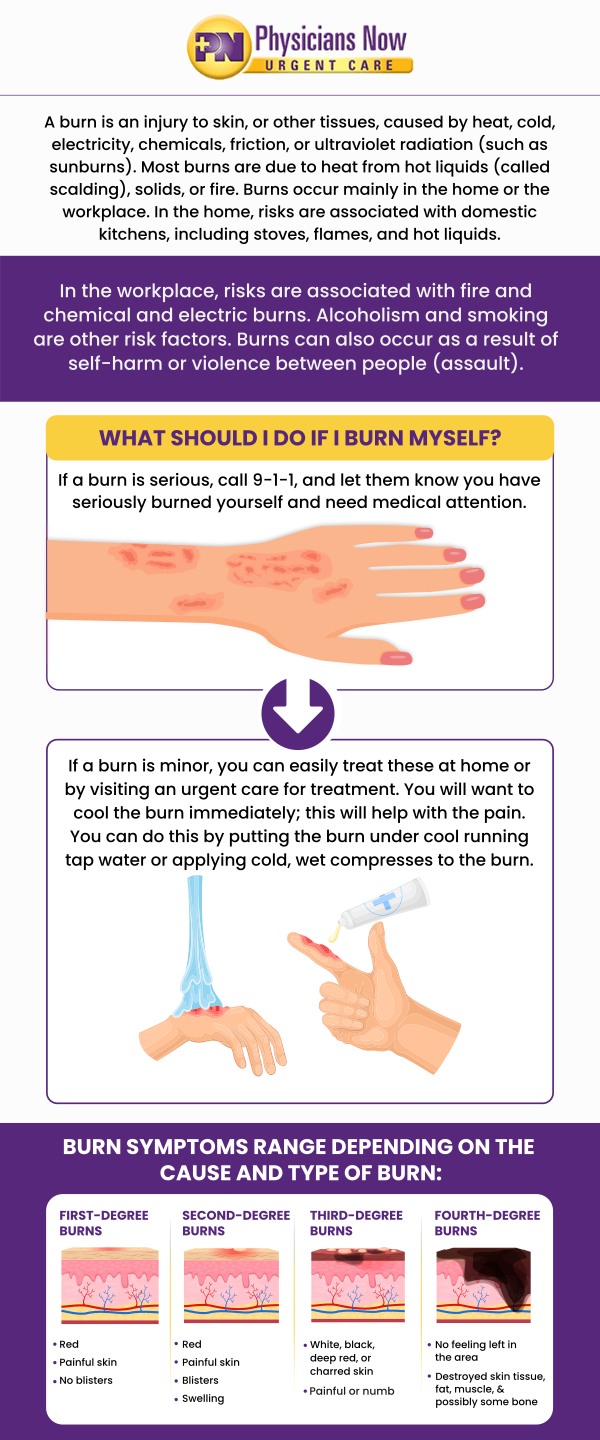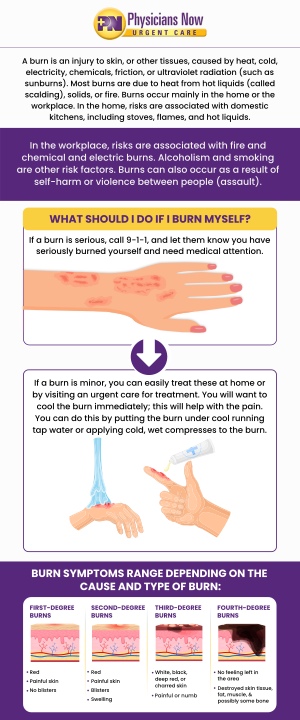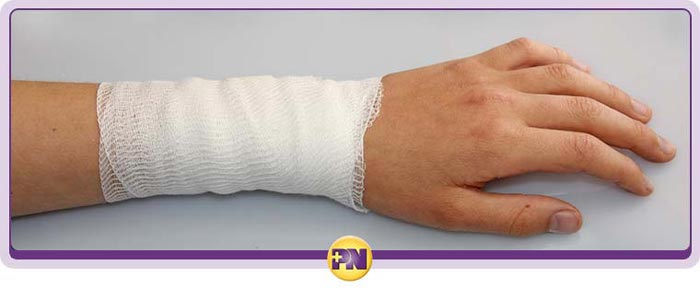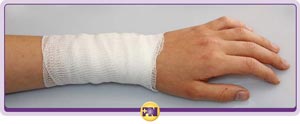Urgent Care for Minor Burns Treatment in Rockville, MD
At Physicians Now Urgent Care in Rockville, MD, we provide prompt and professional treatment for minor burns, helping to alleviate pain, prevent infection, and promote healing. Whether you’ve suffered a burn from cooking, a household accident, or sun exposure, our experienced team, led by Dr. Chinedum Olisemeka, DO, is here to assess the injury and recommend the appropriate course of treatment. From first-degree burns to more severe second-degree burns, we ensure that your skin receives the best care with soothing treatments and aftercare advice. Contact us today for more information or schedule an appointment online. We are conveniently located at 15215 Shady Grove Road, Suite 100, Rockville, MD 20850.




Table of Contents:
Which burn is considered a minor burn?
How can I tell the difference between 1st, 2nd, and 3rd degree burns?
When should I get medical treatment for a burn?
How long does it take burns to heal?
Why Choose Dr. Chinedum Olisemeka, DO, for Minor Burns Treatment in Rockville, MD?
A minor burn is typically a first-degree burn or a small second-degree burn that affects only the outermost layer of skin. First-degree burns are the most common and are often caused by brief exposure to heat, such as a sunburn or a minor contact burn from a hot object. These burns cause redness, mild swelling, and discomfort, but they usually do not result in blisters. First-degree burns generally heal within 7 to 10 days without causing significant long-term damage. As long as the burn is properly cared for, it typically resolves without any need for medical intervention.
A small second-degree burn, which is still considered minor, may involve blistering and swelling, but it typically covers a smaller area of the skin. These burns may be caused by things like a hot pan or a small kitchen mishap. They can heal in about 2 to 3 weeks if properly treated, and they usually do not require advanced medical intervention unless the burn becomes infected or if it affects sensitive areas of the body. It’s important to keep the burn clean and apply the appropriate ointments to help it heal quickly.
At Physicians Now Urgent Care, our medical team offers prompt and professional care for minor burns. Whether it’s a small first-degree burn or a second-degree burn, our clinic is here to ensure your burn is treated quickly and effectively, promoting a smooth recovery and minimizing complications.
The burn symptoms you may notice will range depending on the cause and the type of burn that has resulted:
First-degree burns are mild, and while they do cause some pain, the most visible result you will see is the reddening of the affected skin’s tissue.
Second-degree burns are a level above first-degree burns, and they affect the outer layer of your skin, which is called the epidermis, as well as the lower layer of skin, which is called the dermis. Second-degree burns also cause pain, as well as redness like first-degree burns, with the exception that you can experience swelling and/or blistering associated with second-degree burns.
Third-degree burns are much worse, as they go through the lower layer of skin and affect the individual, as they target the tissues that are found deeper underneath. This burn results in signs of white or even blackened and sometimes charred skin, which may become numb.
Finally, fourth-degree burns are considered one of the worst degrees anyone can have to affect them. This degree of burn goes even deeper than the previous three, as it affects the muscles and bones. Not only are your muscles and bones affected, but fourth-degree burns can also affect the nerve endings by damaging them or destroying them altogether, causing no feeling in the tissues or muscles, and bones of the burned area. Depending on the degree of burn an individual may be affected by, they can go into shock. Symptoms of shock include pale and/or clammy skin, weakness, bluish-looking lips and fingernails, and a drop in the individual’s alertness.
You should seek medical treatment for a burn if the injury is more than just superficial or causes significant pain, swelling, or blistering. Burns that cover a large portion of the body or are located on sensitive areas such as the face, hands, feet, or genital region require immediate medical attention. If the burn appears to be a second-degree or third-degree burn, or if you are unsure about the severity, it is best to consult a healthcare provider. Burns that cause severe pain, cause difficulty breathing, or involve chemicals or electrical sources should always be treated by a medical professional, as they can cause deeper tissue damage that is not immediately visible.
Additionally, burns in individuals with compromised immune systems, such as the elderly, children, or people with pre-existing health conditions, should be assessed by a doctor as they are more susceptible to infections and complications. Signs of infection, such as increased redness, warmth, swelling, or pus, indicate the need for prompt treatment to prevent further health issues. If a burn does not improve or worsens after a few days, it’s crucial to visit a healthcare provider.
At Physicians Now Urgent Care in Rockville, MD, Dr. Chinedum Olisemeka, DO, and our team provide immediate, expert care for burns. Our clinic is dedicated to offering quick, professional treatment in a comfortable and compassionate environment. With the support of our knowledgeable medical staff, you can rest assured that your burn will be treated with the utmost care and efficiency.
The healing time for burns depends on the severity of the burn and the individual’s overall health. Minor burns, such as first-degree burns, typically heal within 7 to 10 days with proper care. These burns affect only the outer layer of skin and are often characterized by redness and mild swelling. With proper wound care, including cooling the area, applying soothing ointments, and keeping the burn clean, the skin begins to regenerate without scarring. However, if the burn is not treated properly, it could take longer to heal and may leave a scar.
Second-degree burns, which affect deeper layers of the skin, may take anywhere from 2 to 3 weeks to heal. These burns cause blisters, intense pain, and swelling. They may require medical attention, such as wound cleaning and the application of topical medications, to prevent infection and promote healing. Healing for second-degree burns varies depending on the burn’s depth, location, and the patient’s health status. Proper aftercare can significantly reduce the healing time and minimize scarring.
Severe burns, such as third-degree burns, may take months to heal, and they may require specialized care such as skin grafts or reconstructive surgery. These burns destroy the skin layers and affect deeper tissues, leading to permanent scarring. At Physicians Now Urgent Care in Rockville, MD, Dr. Chinedum Olisemeka, DO, and our medical team provide expert care for burns of all severities. We prioritize personalized care for every patient, using the latest medical treatments to ensure the fastest and most effective recovery possible.
With over 21 years of experience, Dr. Chinedum Olisemeka, DO, provides expert treatment for minor burns, focusing on quick relief and effective healing. His extensive background allows him to offer personalized care tailored to each patient’s needs, whether it’s for a mild sunburn or a minor kitchen burn. Dr. Olisemeka utilizes the latest medical techniques to ensure prompt treatment and minimize complications, helping you recover with minimal discomfort and scarring.
At Physicians Now Urgent Care in Rockville, MD, Dr. Olisemeka and his compassionate team are committed to providing high-quality care in a comfortable environment. His patient-centered approach ensures that every aspect of your treatment, from immediate care to aftercare instructions, is designed to promote your healing. With over two decades of experience, you can trust Dr. Olisemeka to offer professional, thorough care for your minor burn, helping you get back to your daily routine quickly and safely.
Contact us today for more information. Our urgent care is conveniently located at 15215 Shady Grove Rd., Suite 100, Rockville, MD 20850. We serve patients from Rockville MD, Travilah MD, Lone Oak MD, Colesville Park MD, Redland MD, Darnestown MD, Anscroft MD, and Wheaton-Glenmont MD.

Additional Services You May Need
▸Illness
▸Injuries
▸Acute Care
▸Asthma
▸Head Injury
▸Cholesterol Management
▸Diabetes
▸Flu Shot
▸Heart Disease
▸RSV Testing
▸Pre-Op Clearance

Additional Services You May Need
▸Illness
▸Injuries
▸Acute Care
▸Asthma
▸Head Injury
▸Cholesterol Management
▸Diabetes
▸Flu Shot
▸Heart Disease
▸RSV Testing
▸Pre-Op Clearance





